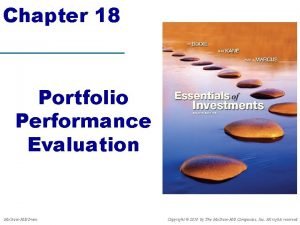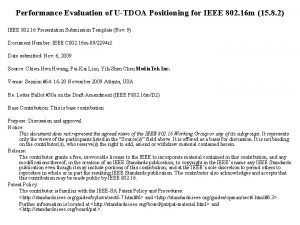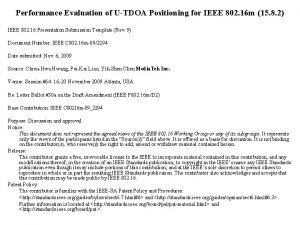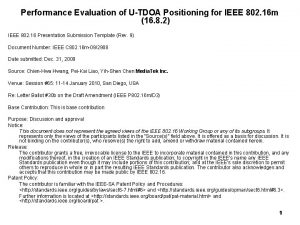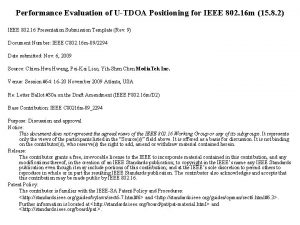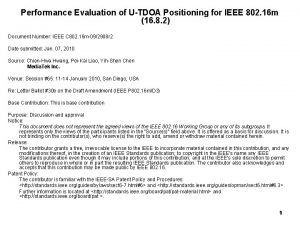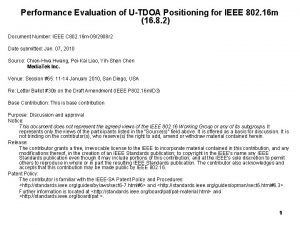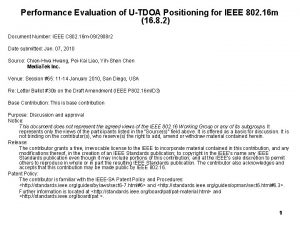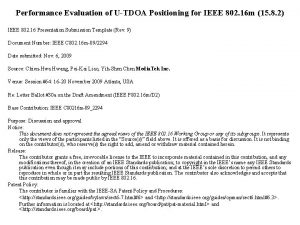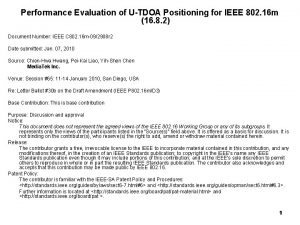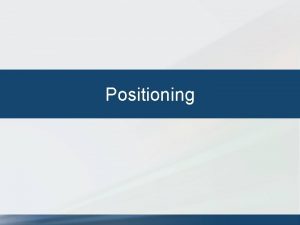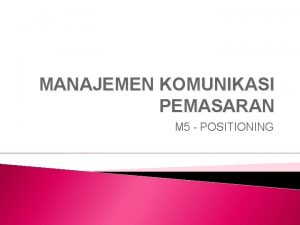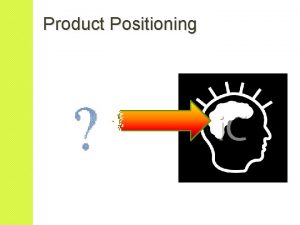Performance Evaluation of UTDOA Positioning for IEEE 802

![Introduction n Performance of D-TDOA positioning was evaluated in [1] in Hawaii, USA (IEEE Introduction n Performance of D-TDOA positioning was evaluated in [1] in Hawaii, USA (IEEE](https://slidetodoc.com/presentation_image_h2/bc1736e6757370ad2e35a11af92091b7/image-2.jpg)

![LBS Performance Requirements n According to IEEE 802. 16 m SRD [3], IEEE 802. LBS Performance Requirements n According to IEEE 802. 16 m SRD [3], IEEE 802.](https://slidetodoc.com/presentation_image_h2/bc1736e6757370ad2e35a11af92091b7/image-4.jpg)








![References [1] IEEE C 80216 m-09/2086, “Evaluation of D-TDOA Positioning” [2] IEEE P 802. References [1] IEEE C 80216 m-09/2086, “Evaluation of D-TDOA Positioning” [2] IEEE P 802.](https://slidetodoc.com/presentation_image_h2/bc1736e6757370ad2e35a11af92091b7/image-13.jpg)
- Slides: 13

Performance Evaluation of U-TDOA Positioning for IEEE 802. 16 m (16. 8. 2) IEEE 802. 16 Presentation Submission Template (Rev. 9) Document Number: IEEE C 802. 16 m-09/2908 r 1 Date submitted: Jan. 05, 2010 Source: Chien-Hwa Hwang, Pei-Kai Liao, Yih-Shen Chen Media. Tek Inc. Venue: Session #65: 11 -14 January 2010, San Diego, USA Re: Letter Ballot #30 b on the Draft Amendment (IEEE P 802. 16 m/D 3) Base Contribution: This is base contribution Purpose: Discussion and approval Notice: This document does not represent the agreed views of the IEEE 802. 16 Working Group or any of its subgroups. It represents only the views of the participants listed in the “Source(s)” field above. It is offered as a basis for discussion. It is not binding on the contributor(s), who reserve(s) the right to add, amend or withdraw material contained herein. Release: The contributor grants a free, irrevocable license to the IEEE to incorporate material contained in this contribution, and any modifications thereof, in the creation of an IEEE Standards publication; to copyright in the IEEE’s name any IEEE Standards publication even though it may include portions of this contribution; and at the IEEE’s sole discretion to permit others to reproduce in whole or in part the resulting IEEE Standards publication. The contributor also acknowledges and accepts that this contribution may be made public by IEEE 802. 16. Patent Policy: The contributor is familiar with the IEEE-SA Patent Policy and Procedures: <http: //standards. ieee. org/guides/bylaws/sect 6 -7. html#6> and <http: //standards. ieee. org/guides/opman/sect 6. html#6. 3>. Further information is located at <http: //standards. ieee. org/board/pat-material. html> and <http: //standards. ieee. org/board/pat >. 1
![Introduction n Performance of DTDOA positioning was evaluated in 1 in Hawaii USA IEEE Introduction n Performance of D-TDOA positioning was evaluated in [1] in Hawaii, USA (IEEE](https://slidetodoc.com/presentation_image_h2/bc1736e6757370ad2e35a11af92091b7/image-2.jpg)
Introduction n Performance of D-TDOA positioning was evaluated in [1] in Hawaii, USA (IEEE Session #63. 5) n This document defines some specific assumptions required for U-TDOA based positioning evaluation and presents simulation results for U-TDOA positioning that were obtained with specified assumptions n This contribution is compliant with the latest version of IEEE 802. 16 m/D 3 [2] 2

Motivation n One of the most powerful ways to personalize mobile services is based on location. One of the most obvious technologies behind location based service (LBS) is positioning n Strict requirements on user positioning accuracy are imposed on existing location services such as wireless Enhanced 911 and new upcoming services n It is imperative to verify whether IEEE 802. 16 m network is able to meet the positioning accuracy requirements 3
![LBS Performance Requirements n According to IEEE 802 16 m SRD 3 IEEE 802 LBS Performance Requirements n According to IEEE 802. 16 m SRD [3], IEEE 802.](https://slidetodoc.com/presentation_image_h2/bc1736e6757370ad2e35a11af92091b7/image-4.jpg)
LBS Performance Requirements n According to IEEE 802. 16 m SRD [3], IEEE 802. 16 m systems should provide support for LBS. IEEE 802. 16 m systems should satisfy the requirements in the following table LBS Requirements Feature Requirement Location determination latency < 30 sec Handset-based position accuracy (in meters) 50 meter (67%-tile of the CDF of the position accuracy) 150 meter (95%-tile of the CDF of the position accuracy) Network-based position accuracy (in meters) 100 meter (67%-tile of the CDF of the position accuracy) 300 meter (95%-tile of the CDF of the position accuracy) Comments Need to meet E 911 Phase II Requirements 4

TOA Estimation Algorithm n n n Serving ABS and two neighbor ABSs cooperate to perform positioning Format 0 non-synchronized ranging signal is transmitted by the AMS to be positioned Code index of Zadoff-Chu sequence adopted by the AMS is known to the serving and neighbor ABSs Serving and neighbor ABSs execute TOA estimations for the ranging signal transmitted by the AMS U-TDOA is computed based on TOAs of serving and neighbor ABSs using algorithm of [4] Block diagram of TOA estimation is shown in the figure below Ranging Signal LPF RCP Removal FFT RCP: Ranging Cyclic Prefix Extraction of Ranging Code Zero Padding Ranging Code IFFT Peak Test Obtain Timing 5

Simulation Assumptions System Parameters Bandwidth, FFT size, CP ratio 10 MHz, 1024 points, 1/8 Carrier frequency 2. 5 GHz OFDMA symbols per subframe 6 Ranging signal format Format 0 non-synchronized ranging channel in IEEE 802. 16 m, Draft 3 [2] Equipment Model ABS Number of RX antennas 2 Antenna gain 17 d. Bi, q 3 d. B = 70°, Max. attenuation 20 d. B Noise figure 5 d. B Cable loss 2 d. B AMS Number of TX antennas 1 Antenna gain Omni, 0 d. Bi Maximum Tx power 23 d. Bm Deployment Parameters Cell layout Hexagonal grid, Warp around Inter-site distance 1500 m Shadowing factor Lognormal shadowing std. dev. 8 d. B, Correlation distance of shadowing 50 m Channel model Modified ITU Pedestrian B Channel, velocity 3 km/hr Path loss model PL (d. B) = 130. 19 + 37. 6 log 10 (R [km]) Penetration loss 10 d. B Frequency reuse factor 1 Others TDOA algorithm Algorithm for nonlinear least squares problems in Reference [4] 6

Interference Model n For serving and neighbor ABSs Signal to thermal noise ratio (SNR) is fixed as 10 d. B ¨ Intercell interference to thermal noise ratio (Io. T) is Gaussian with mean [0, 3. 5, 7] d. B and variance 2 d. B ¨ Based on SNR and Io. T setting, average signal to intercell interference plus thermal noise ratio (SINR) is [7, 4. 9, 2. 2] d. B ¨ Intracell interference appears because subcarrier orthogonality between nonsynchronized ranging signal and regular OFDM signal cannot be maintained ¨ n In the cell of serving ABS Another AMS is doing ranging at the same subband with probability [0, 0. 5], called ranging collision rate ¨ Other subbands (besides the subband for ranging) are carrying data ¨ n In the cells of neighbor ABSs Ranging subband is occupied by another AMS (sending data) with probability [0, 0. 5], called interference collision rate ¨ Other subbands (besides the subband for ranging) are carrying data ¨ 7

Simulation Results (1/3) n Average intercell interference to noise ratio (Io. T) = 0 d. B; 2 ranging channels ICR = 0. 5 ICR: Interference Collision Rate RCR: Ranging Collision Rate 8

Simulation Results (2/3) n Average intercell interference to noise ratio (Io. T) = 3. 5 d. B; 2 ranging channels ICR = 0. 5 ICR: Interference Collision Rate RCR: Ranging Collision Rate 9

Simulation Results (3/3) n Average intercell interference to noise ratio (Io. T) = 7 d. B; 2 ranging channels ICR = 0. 5 ICR: Interference Collision Rate RCR: Ranging Collision Rate 10

Conclusion n Performance of U-TDOA deteriorates due to In the serving cell, other AMSs are doing ranging ¨ In the cells of neighbor ABSs, some AMSs are sending data using the ranging subband ¨ Intercell interference from adjacent cells ¨ n U-TDOA positioning based on current ranging channel allocation scheme is NOT able to meet strict Enhanced 911 Phase II requirements in interference limited multipath environment n It is suggested to have a dedicated positioning radio resource (such as an FDM zone) among cooperative ABSs for U-TDOA and TOA 11

Text Proposal 16. 8. 2. 2 12
![References 1 IEEE C 80216 m092086 Evaluation of DTDOA Positioning 2 IEEE P 802 References [1] IEEE C 80216 m-09/2086, “Evaluation of D-TDOA Positioning” [2] IEEE P 802.](https://slidetodoc.com/presentation_image_h2/bc1736e6757370ad2e35a11af92091b7/image-13.jpg)
References [1] IEEE C 80216 m-09/2086, “Evaluation of D-TDOA Positioning” [2] IEEE P 802. 16 m/D 3. “DRAFT Amendment to IEEE Standard for Local and metropolitan area networks—Part 16: Air Interface for Broadband Wireless Access Systems—Advanced Air Interface” / December 2009 [3] IEEE 802. 16 m-07/002 r 9, “IEEE 802. 16 m System Requirement Document (SRD)”/ 2009 -09 -24 [4] Fletcher, R. , (1971): A Modified Marquardt Subroutine for Nonlinear Least Squares. Rpt. AERE-R 6799, Harwell 13
 Bridges from 802.x to 802.y
Bridges from 802.x to 802.y Bridges from 802.x to 802.y
Bridges from 802.x to 802.y 802 ieee
802 ieee 802 ieee
802 ieee Ieee 802 family
Ieee 802 family Ieee802.22
Ieee802.22 Ieee 802 standard
Ieee 802 standard Ieee 802
Ieee 802 Ieee 802 3 compliance
Ieee 802 3 compliance Arquitetura ieee 802
Arquitetura ieee 802 Ieee 802 bluetooth
Ieee 802 bluetooth Positioning involves meeting consumers lower performance
Positioning involves meeting consumers lower performance Computer architecture performance evaluation methods
Computer architecture performance evaluation methods Portfolio performance evaluation problems
Portfolio performance evaluation problems













